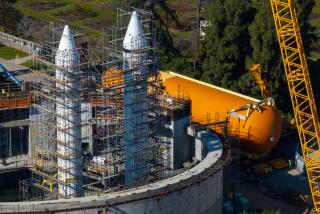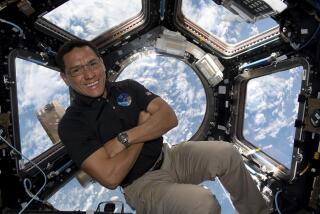A Long Way From CSUN : Alumnus Guides Shuttle on His First Blastoff Into Space
- Share via
Blasting skyward on a thundering cloud of white smoke, the space shuttle Columbia was launched into space Thursday with CSUN alumnus Scott Horowitz in the pilot’s seat.
Horowitz, who was raised in Thousand Oaks, took off aboard Columbia at 12:18 p.m. local time from Kennedy Space Center in Florida with six other astronauts on a 14-day mission to generate electricity with an Italian satellite on a conducting tether.
The tether, which scientists compare to a shoelace, is about a 10th of an inch thick and 12.8 miles long. Like the string of a kite, the tether will drag the satellite, a half-ton metal ball, through space.
This will be the satellite’s second try in space.
In the summer of 1992, the tether got tangled on a protruding safety bolt and the satellite was deployed only 800 feet--not far enough to generate sufficient power for the experiment.
But for Horowitz, 38, it’s a first.
As the son of a Navy pilot, Horowitz began flying with his father at the age of 6 and decided to become an astronaut at 12. “I was a late starter,” he told a NASA interviewer before the launch.
After graduating from Cal State Northridge in 1978 with an engineering degree, he headed to the Southeast to study aerospace engineering at Georgia Institute of Technology. Horowitz finished in 1982 with a doctorate. Making history as the first space shuttle pilot with the degree earned him the nickname “Doc” at NASA.
Professor Ben Zinn, who served as doctoral advisor to Horowitz in Georgia, said the affable student developed a computer program to assist NASA with noise emissions. Zinn said Horowitz pursued a doctorate because he thought it would give him a better crack at the astronaut program.
But his constant worry as a future shuttle pilot was fear of failing eyesight.
“We would all laugh at him because he would spend his time doing these crazy eye exercises,” Zinn said. “I’m so excited for him. If you talk to anybody, they’ll agree, he’s just a great guy.”
After Georgia, Horowitz joined the Air Force and earned the rank of lieutenant colonel. Eventually, his career brought him back West in 1990 when he attended the test pilot school at Edwards Air Force Base. He became an astronaut in 1992.
The flight is NASA’s 75th space shuttle mission and is a combined effort with the Italian Space Agency. The international crew includes Horowitz and three other Americans, two Italians and one Swiss. Four of the team were on the original flight in 1992. Training for the mission included two years in ground simulators to prepare the men for any mishaps.
Countdown was briefly held up Thursday when shuttle commander Andrew Allen reported engine trouble. An errant gauge was to blame and Mission Control gave the thumbs up soon after.
NASA spokeswoman Eileen Hawley said scientists hope the $443-million mission will provide a new way to boost altitude in space without using traditional propellants. The mission will also carry special scientific equipment to study condensed matter physics in space.
“The mission is pure research using a better laboratory than we have on earth,” Hawley said. “We also hope to find out more about what we call ‘plasma’. Lightning and aurora borealis are some forms of plasma.”
The most complex parts of the mission begin Saturday about 3:30 p.m. when Horowitz and the rest of the crew will set the tether with the satellite hanging on its end into the Earth’s magnetic field at five miles per second. The satellite will soar above Columbia for two days, when scientists expect 1,000 watts of power to be produced through a current flowing from the satellite, down the tether and back to Columbia.
On Monday about 12:30 p.m., the crew will reel the satellite back inside the shuttle.
Cal State Northridge professor Tim Fox, who taught Horowitz in his junior year, said he has no doubt his former student will succeed.
“Scott’s no-nonsense. He finished in three years, because he’s quick and sharp,” Fox said. “But he wasn’t one of those guys who was good in school and a loner. I remember him because not only was he an outstanding student, he was friendly and smiled a lot.”
Columbia is scheduled to return to earth on March 7.
Among those looking forward to his return is the alumni office at Cal State Northridge, which wants Horowitz to speak at graduation.
More to Read
Sign up for Essential California
The most important California stories and recommendations in your inbox every morning.
You may occasionally receive promotional content from the Los Angeles Times.












